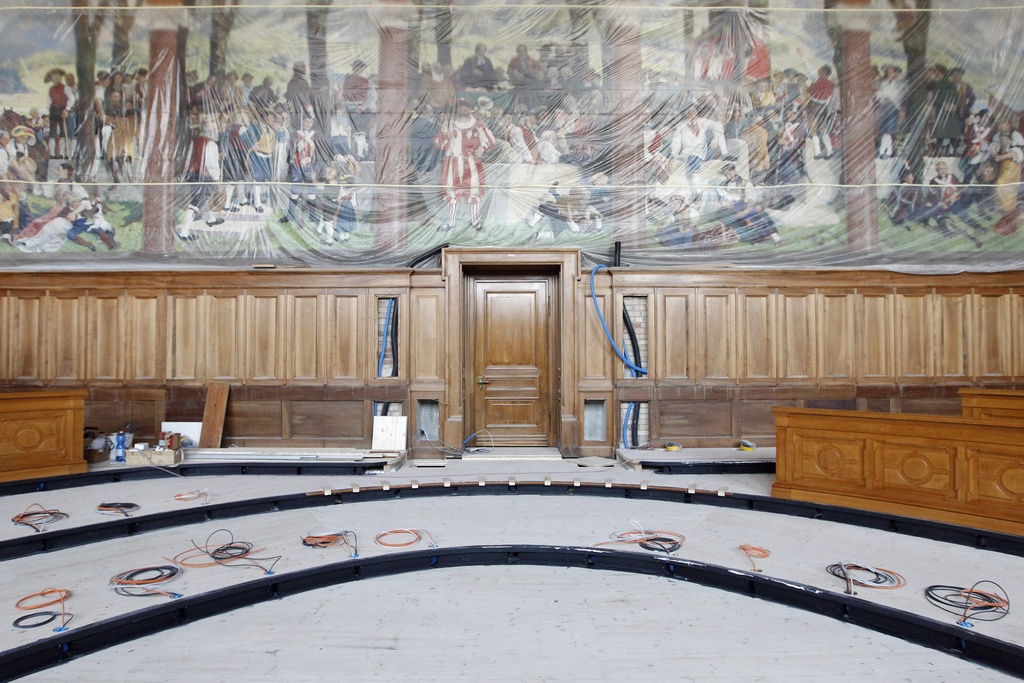
The outsized, shifting power of the Swiss Senate

In view of next year’s parliamentary elections, everyone talks about the significance of the House of Representatives. But the most important political ballot will not take place in this first chamber of the Swiss parliament – the Senate will decide the outcome of the elections.
With a mere 46 seats, the senate is the Swiss parliament’s second chamber, reserving two seats for every canton and one for every half-canton. Yet despite its small size, the outcome of the 2019 elections will be especially significant – even decisive – in this institution.
Why? Firstly, some 14 senators have either decided to step down in 2019 or are seriously thinking about it. In addition, the senator who was elected to the cabinet on December 5 will also have to be replaced at the beginning of 2019.
Adding this all up, one third of the senate may have to be newly elected, a new record since the turn of the millennium. And, now more than ever, such a scenario would be an opportunity for the second chamber to reach a turning point.
Mutation of the left
The number alone is impressive, but the distribution of the resignations among the parties is also extraordinary: fully half come from a single party – the conservative right Swiss People’s Party.
And yet, even with not all candidates yet announced, it seems certain that the left will suffer most losses. While the Social Democrats of canton Basel City will most likely keep their Senate seats, it’s widely expected their colleagues in canton Aargau will lose a seat.
And with all other Social Democrat seats set to be contentious at the least, there are hardly any real chances for the party to win. At best, they will lose one seat next year; at worst, they could lose as many as five.
This would amount to a decimation, bringing to an end the party’s long-term rise in the senate: while in 1991 they held just three seats in the chamber, they have grown every year since (except for 2007). They currently constitute the third-strongest party in the Senate, with just one seat fewer than the Radical-Liberals and the Christian Democrats.
Strong female candidates played a big part in the rise. However, the era of women’s power seems to be over. All four sitting female Social Democratic senators are not running in 2019, and for at least three of the four seats, male candidates have already been nominated or are in pole position within their party.
But the ultimate reason for the decline is the party’s new shift to the left: even though this secures votes in the proportional representation system, in the majority system – applied in the senate – it diminishes the chances to link up with another party.
This was something the Social Democrats experienced in the latest cantonal elections, when their representatives in cantons including Basel Country, Lucerne or Schwyz were voted out of local governments.
Relegated to the back seat
As opposed to the House of Representative, the majority voting system is quite liberal in the senate. The Christian Democrats and the Radicals remain at the centre of decision-making, and when differences occur, they join up with the Social Democrats to form a majority. The Swiss People’s Party is denied this option, not having enough seats.
With centrist and left-wing parties dominant in the senate since 2011, majorities reached by the Swiss People’s Party and the Radicals in the first chamber are often blocked; this dynamic is what’s at stake in 2019.
With their current 12 senators, the Social Democrats manage to have specialists represent them in numerous senate committees; they can also win majorities in the plenary if they agree with the Radicals and Christian Democrats on socio-political questions.
Heavy losses would thus relegate the Social Democrats from the driver’s to the back seat.
Radical offensive
“We want to break the centre-left majority in the senate,” the Radical party president Petra Gössi said recently in an interview. She reckons the shift to the right that was widely expected post-2015 never completely materialised; though the House of Representatives moved in that direction, the senate was largely affected.
And yet, a new book by Bern political scientist Adrian Vatter about the Swiss parliament shows that despite Switzerland’s well-balanced two-chamber parliament, the smaller chamber clearly has greater weight than the much bigger House (200 seats).
Firstly, he reckons, the second chamber works more closely with the government than the first, which makes it more likely to support proposals submitted by the government. Due to its small size, the senate is also more efficient, and often ends up having more influence on the general thrust of legislation.
Finally, the small chamber’s negotiations are less polarised. At the end of the day, politicians want solutions that take into account the concerns of both sides.
The new versions of the rejected corporate tax reform and the revision of the state pension system have been drafted by the senate. And though the Radicals and the Christian Democratic Party laid the foundation, they still needed two of the six Social Democratic senators to reach consensus.
My theory is that changes in the senate – namely, vacated seats by the Social Democrats changing the balance of power – will be more sustainable than in the House, and that’s exactly where the big 2019 turning point will be.
Translated from German by Billi Bierling

In compliance with the JTI standards
More: SWI swissinfo.ch certified by the Journalism Trust Initiative






























You can find an overview of ongoing debates with our journalists here . Please join us!
If you want to start a conversation about a topic raised in this article or want to report factual errors, email us at english@swissinfo.ch.